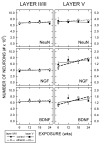Neurotrophin ligand-receptor systems in somatosensory cortex of adult rat are affected by repeated episodes of ethanol
- PMID: 17320080
- PMCID: PMC1995597
- DOI: 10.1016/j.expneurol.2006.12.022
Neurotrophin ligand-receptor systems in somatosensory cortex of adult rat are affected by repeated episodes of ethanol
Abstract
Ethanol exposure profoundly affects learning and memory and neural plasticity. Key players underlying these functions are neurotrophins. The present study explored the effects of ethanol on the distribution of neurotrophins in the cerebral cortex of the adult rat. Age- and weight-matched pairs of adult male, Long-Evans rats were fed a liquid, ethanol-containing (6.7% v/v) diet or pair-fed an isocaloric control diet three consecutive days per week for 6, 12, 18, or 24 weeks. Brains were processed immunohistochemically for nerve growth factor (NGF) and brain-derived neurotrophic factor (BDNF) expression and for the expression of three neurotrophin receptors, p75, trkA, and trkB. Total numbers of immunolabeled neurons in specific layers of somatosensory cortex of ethanol- and control-fed animals were determined stereologically. Ethanol exposure induced an increase in the numbers of NGF- or BDNF-expressing neurons and in neurotrophin content per somata. These changes were (a) time and (b) laminar dependent. In contrast, the number of receptor-expressing neurons did not change due to ethanol exposure or to length of time on the ethanol diet. Thus, ethanol induces the recruitment of cortical neurons to express neurotrophins and an increase in the amount of neurotrophin expression per neuron.
Figures






Similar articles
-
Repeated episodic exposure to ethanol affects neurotrophin content in the forebrain of the mature rat.Exp Neurol. 2004 Sep;189(1):173-81. doi: 10.1016/j.expneurol.2004.05.026. Exp Neurol. 2004. PMID: 15296847
-
Expression of nerve growth factor, brain-derived neurotrophic factor, and neurotrophin-3 in the somatosensory cortex of the mature rat: coexpression with high-affinity neurotrophin receptors.J Comp Neurol. 2000 Mar 13;418(3):241-54. doi: 10.1002/(sici)1096-9861(20000313)418:3<241::aid-cne1>3.0.co;2-m. J Comp Neurol. 2000. PMID: 10701824
-
Chronic exposure to ethanol alters neurotrophin content in the basal forebrain-cortex system in the mature rat: effects on autocrine-paracrine mechanisms.J Neurobiol. 2004 Sep 15;60(4):490-8. doi: 10.1002/neu.20059. J Neurobiol. 2004. PMID: 15307153
-
Interactions of estrogen with the neurotrophins and their receptors during neural development.Horm Behav. 1994 Dec;28(4):367-75. doi: 10.1006/hbeh.1994.1033. Horm Behav. 1994. PMID: 7729805 Review.
-
Neurotrophins in cultured cells from periodontal tissues.J Periodontol. 2003 Jan;74(1):76-84. doi: 10.1902/jop.2003.74.1.76. J Periodontol. 2003. PMID: 12593600 Review.
Cited by
-
Communication networks in the brain: neurons, receptors, neurotransmitters, and alcohol.Alcohol Res Health. 2008;31(3):196-214. Alcohol Res Health. 2008. PMID: 23584863 Free PMC article. Review.
-
Mystic Acetaldehyde: The Never-Ending Story on Alcoholism.Front Behav Neurosci. 2017 May 11;11:81. doi: 10.3389/fnbeh.2017.00081. eCollection 2017. Front Behav Neurosci. 2017. PMID: 28553209 Free PMC article. Review.
-
Small molecule p75NTR ligand prevents cognitive deficits and neurite degeneration in an Alzheimer's mouse model.Neurobiol Aging. 2013 Aug;34(8):2052-63. doi: 10.1016/j.neurobiolaging.2013.02.015. Epub 2013 Mar 29. Neurobiol Aging. 2013. PMID: 23545424 Free PMC article.
-
A high soy diet enhances neurotropin receptor and Bcl-XL gene expression in the brains of ovariectomized female rats.Brain Res. 2007 Jul 23;1159:54-66. doi: 10.1016/j.brainres.2007.05.026. Epub 2007 May 26. Brain Res. 2007. PMID: 17582385 Free PMC article.
-
Short-term ethanol exposure causes imbalanced neurotrophic factor allocation in the basal forebrain cholinergic system: a novel insight into understanding the initial processes of alcohol addiction.J Neural Transm (Vienna). 2014 Feb;121(2):201-10. doi: 10.1007/s00702-013-1085-y. Epub 2013 Sep 6. J Neural Transm (Vienna). 2014. PMID: 24061482
References
-
- Aloe L, Tirassa P. The effect of long-term alcohol intake on brain NGF-target cells of aged rats. Alcohol. 1992;9:299–304. - PubMed
-
- Aloe L, Tuveri MA, Guerra G, Pinna L, Tirassa P, Micera A, Alleva E. Changes in human plasma nerve growth factor level after chronic alcohol consumption and withdrawal. Alcohol Clin Exp Res. 1996;20:462–465. - PubMed
-
- Arendt T. Impairment in memory function and neurodegenerative changes in the cholinergic basal forebrain system induced by chronic intake of ethanol. J Neural Trans Supplementum. 1994;44:173–187. - PubMed
Publication types
MeSH terms
Substances
Grants and funding
LinkOut - more resources
Full Text Sources
Research Materials

